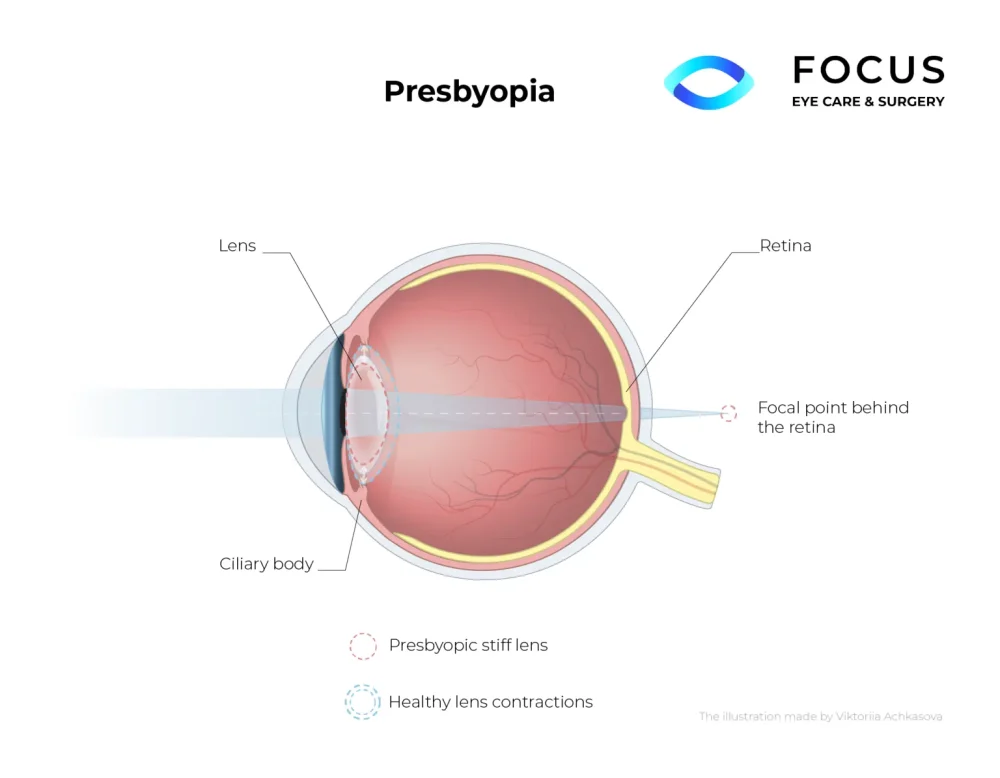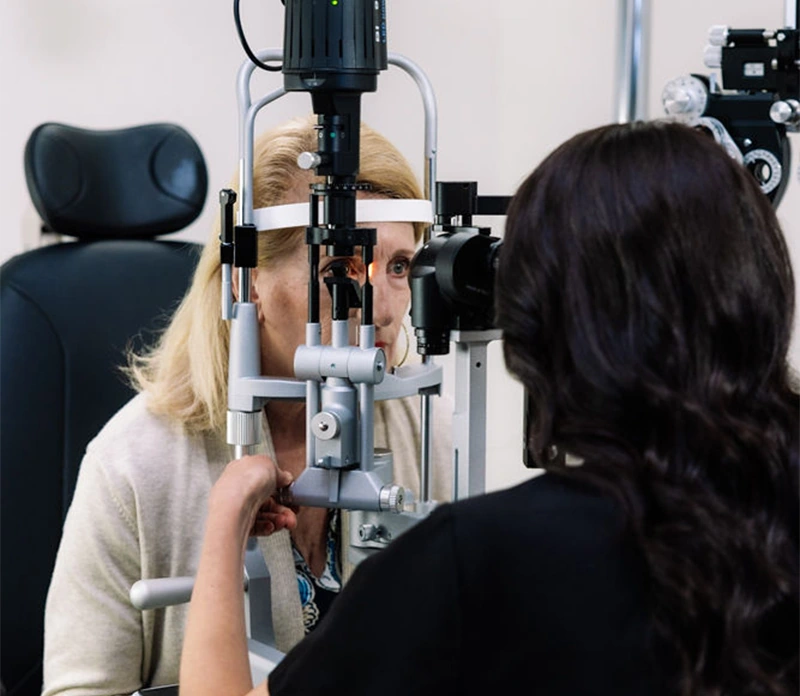Presbyopia
Does Presbyopia Prevent You From Enjoying Work Up Close?
If you’re over 40 and find yourself holding books, menus, or your phone farther away to see clearly, you may be experiencing presbyopia. This common, age-related condition makes it more difficult to focus on close objects and can be frustrating as it affects daily tasks. Fortunately, for patients in Queens, Long Island, and NYC, Focus Eye Care offers a range of personalized treatments to help restore your near vision. Our experienced team is here to evaluate your condition and recommend a solution that fits your unique needs and lifestyle.
What Is Presbyopia?
Presbyopia is a common, age-related condition that affects nearly everyone as they get older, typically starting in their 40s. As the natural lens of the eye becomes less flexible over time, it loses its ability to focus on objects up close.
This results in near vision difficulties, such as needing reading glasses to see clearly at close distances. Unlike other refractive errors like nearsightedness, farsightedness, or astigmatism, presbyopia isn’t related to the shape of the eye, but rather to the natural aging process and the loss of
Trusted Source
What is Presbyopia?
American Academy of Ophthalmology
Go to Source
lens elasticity.



Symptoms of Presbyopia
Symptoms of presbyopia typically begin to appear in the early 40s as near vision becomes more challenging. Common symptoms include:
- Blurred vision when reading or focusing on close-up tasks
- Needing to hold reading materials farther away to see clearly
- Difficulty reading small print or fine details
- Eye strain or headaches, especially during prolonged close-up work
- Increased difficulty seeing in
Trusted Source Presbyopia National Eye Institute Go to Source dim lighting
For many people, these symptoms may worsen in low light or when they are fatigued.

Presbyopia is a natural part of the aging process, and it affects nearly everyone, typically starting in their 40s. However, some individuals may notice signs of near vision loss earlier than others. Risk factors that can contribute to premature presbyopia include:
- Farsightedness (hyperopia)
- Diabetes
- Cardiovascular disease
- Anemia
- Multiple sclerosis
- A history of eye injury or trauma
-
Trusted Source Presbyopia Mayo Clinic Go to Source Certain medications
While presbyopia is inevitable, these factors may influence when symptoms first appear.
Presbyopia Treatment Options
There are a variety of effective treatments available to help manage the effects of presbyopia and restore near vision. Options range from simple, non-invasive methods to more permanent solutions:
Eyeglasses
For many, reading glasses, bifocals, or multifocal or progressive lenses are a convenient first step in correcting near vision loss. These options help patients see clearly up close without the need for surgery.
Monovision/Blended Vision
Monovision involves correcting one eye for near vision and the other for distance. This can be done temporarily with contact lenses or as a more permanent solution through LASIK, PRK, or refractive lens exchange (RLE). For patients who adapt well to this technique, monovision can reduce or even eliminate dependence on glasses.
Refractive Lens Exchange (RLE)
Refractive lens exchange is a surgical procedure similar to cataract surgery, where the eye’s natural lens is replaced with an intraocular lens (IOL) to improve vision. By customizing the IOL to meet each patient’s specific visual needs, RLE offers a long-term solution for presbyopia and may eliminate the future need for cataract surgery.
For patients interested in exploring the best treatment options for their lifestyle, a consultation with our eye care team can provide tailored guidance.

FAQs About Presbyopia
If you are over 40 and find yourself holding reading material further away to focus or having difficulty seeing close-up objects, you may have presbyopia. Scheduling an eye exam is the best way to confirm the diagnosis and explore treatment options.
Presbyopia is typically diagnosed during a comprehensive eye exam. Your eye doctor will assess your overall vision and may perform specific tests to evaluate how well your eyes focus on objects at different distances. If you’ve noticed difficulty with near vision tasks, such as reading or seeing close-up details, an eye exam is the best way to determine if presbyopia is the cause and explore treatment options.
Presbyopia is a natural part of the aging process and cannot be prevented. However, maintaining good eye health with regular eye exams, a balanced diet, and sun protection can help protect overall vision.
Yes, LASIK and other refractive surgeries correct vision by reshaping the cornea but do not prevent the age-related changes to the lens that cause presbyopia. You may still experience presbyopia even after undergoing these procedures.
While both presbyopia and farsightedness (hyperopia) affect near vision, farsightedness is a condition present from birth and caused by the shape of the eye. Presbyopia, on the other hand, is age-related and results from the hardening of the eye’s natural lens, making it difficult to focus on close objects.
LASIK cannot cure presbyopia, but it can improve near vision with techniques like monovision LASIK, which corrects one eye for distance and the other for close-up vision. Your ophthalmologist will discuss monovision LASIK with you as part one of your presbyopia treatment options. However, for many patients, refractive lens exchange may be a more effective long-term solution.


Contact Us
If you’re experiencing symptoms of presbyopia or struggling with near vision tasks, the team at Focus Eye Care is here to help. We offer customized treatment options to restore your vision and improve your quality of life. Contact us today to schedule an eye exam and discuss presbyopia solutions tailored to your needs. Serving patients throughout Queens, Long Island, and the New York City area, we are committed to helping you see clearly again.
1 American Academy of Ophthalmology. What is Presbyopia? Available: https://www.aao.org/eye-health/diseases/what-is-presbyopia. Accessed October 8, 2023.
2 National Eye Institute. Presbyopia. Available: https://www.nei.nih.gov/learn-about-eye-health/eye-conditions-and-diseases/presbyopia Accessed October 8, 2024.
3 Mayo Clinic. Presbyopia. Available: https://www.mayoclinic.org/diseases-conditions/presbyopia/symptoms-causes/syc-20363328. Accessed October 8, 2024.
The doctors at Focus Eye Care & Surgery have reviewed and approved this content.
Page Updated:


